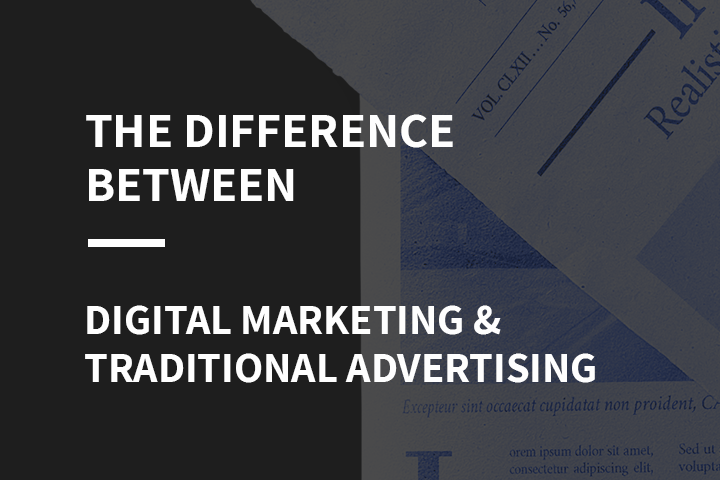The Difference Between Digital Marketing & Traditional Advertising

Since the first American television advertisement aired in 1941, there has been a flood of ads on every channel possible. Radio, TV, print and film have all been the ideal mediums for advertisers to market their products or services to the masses since it all began almost 75 years ago. Luckily for us, technology has advanced enough to bring about the dawn of a new area—digital marketing.
Not to be mistaken as another channel for advertisements, digital marketing encompasses many marketing opportunities such as blogging, mobile, social media, email marketing, search engine marketing and more! In 2017, TV ad spending totaled roughly $72.01 billion, or 35.8% of total media investments in the United States; total digital ad spending was about $77.37 billion, or 38.4% of total ad spending. Over one-third of CMOs believe that digital will account for 75% of marketing spend in the next five years — so understanding what makes digital so vital is the first step in gearing up your business to make a mark on the internet.
Value vs. Advertising
The primary difference between digital marketing and traditional advertising is that many digital marketers look to provide value to their audience by using content marketing and other solutions. Traditional advertisers are typically just looking to increase sales with their ad spots, not to provide value.
So, what does providing value look like? One-third of the world uses social media regularly, making it an excellent channel to connect with a target audience. A social media marketer is able to research what their audience is interested in and cares about using page analytics, molding their brand and messaging to actually offer solutions, information or even entertainment to their audience; this provides value to the audience, building trust and ultimately turning them into repeat customers. Building a real, valuable business-to-consumer relationship is something a print or radio ad simply cannot do.
Communication
A great business knows that word of mouth travels and motivates purchase behavior. With social media discussions and search engine reviews, there are many ways for customers to share their experiences with their friends. With that being said, social media and email marketing are examples of how digital marketing offers two-way communication, allowing for feedback and relationship building.
Traditional marketing is solely one-way communication, showcasing a product, event or service and leaving it at that. When you can connect with your audience and offer solutions to their wants and needs, they practically do your marketing for you.
Data-driven
When purchasing an ad spot on radio or TV, you aren’t given much more information than the number of listeners in that market (maybe a profile of the average listener, if you’re lucky). With digital marketing, targeting features for campaigns are unmatched by traditional advertising. In a social media campaign, you can create a whole custom audience of people to reach or create an audience solely of people who have already visited your website.
When marketing on search engines like Google, you can target people who are searching for exactly what your business is offering! Digital marketing takes out the guesswork by providing in-depth analytics and metrics about your audience and your marketing efforts.
Is digital marketing better than traditional advertising?
With traditional advertising, you are in the dark regarding understanding your return on investment (ROI). Digital marketing not only tracks your ROI, but its analytic capabilities give you the opportunity to enhance it. Knowing what you spend and what you get in return is the key benefit of digital marketing versus traditional advertising. Every day, more people are using the internet for music, TV, film and news, which raises the question of whether traditional advertising is even worth it anymore.


